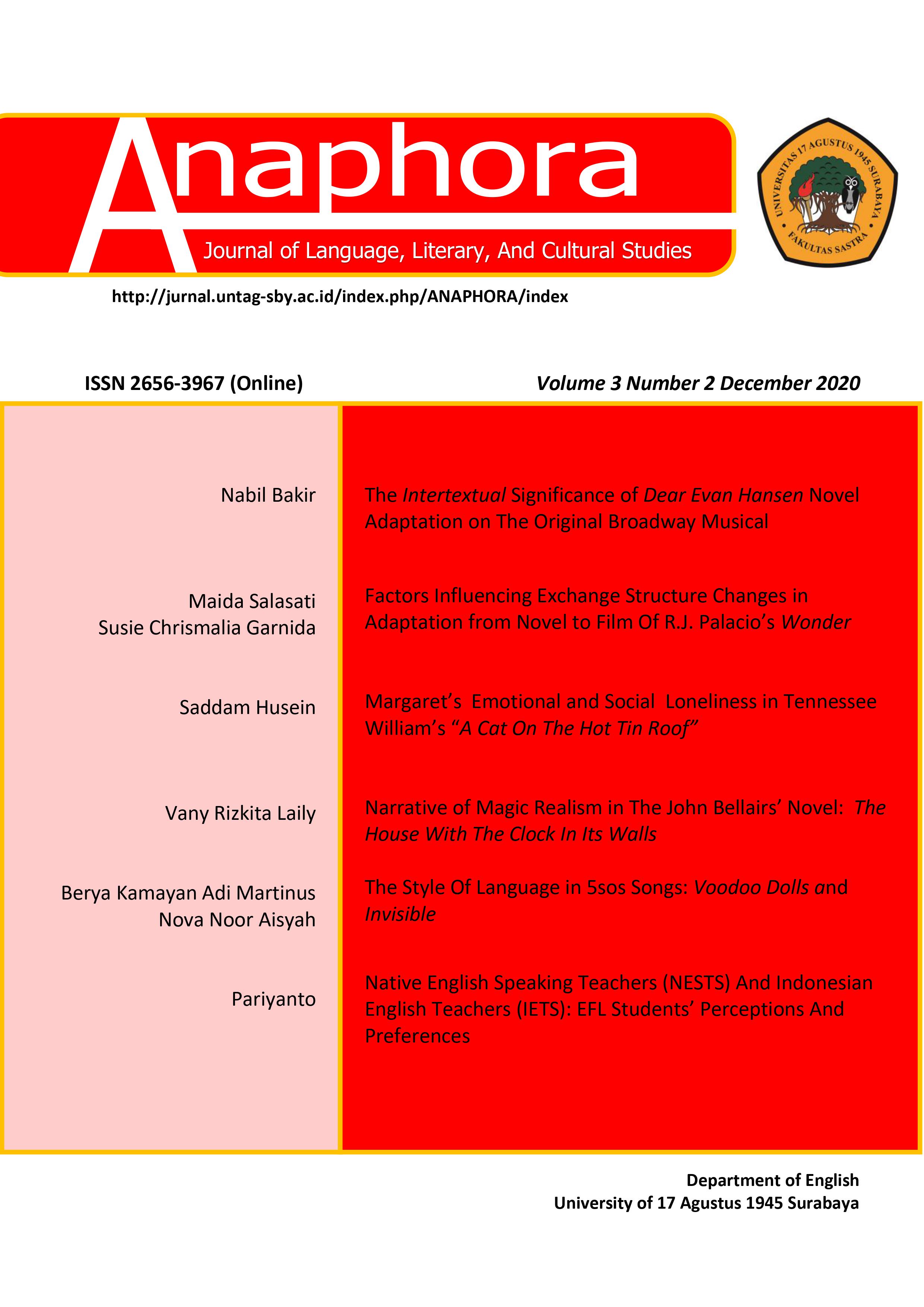FACTORS INFLUENCING EXCHANGE STRUCTURE CHANGES IN ADAPTATION FROM NOVEL TO FILM OF R.J. PALACIO’S WONDER
DOI:
https://doi.org/10.30996/anaphora.v3i2.3505Keywords:
adaptation, fidelity, exchange structureAbstract
This article reports a study on conversational aspects of adaptation from novel to movie. Specifically it reports the exchange structure changes when dialogues in novel is adapted into movie, the issue of fidelity that is involved in the changes, and how the changes affect information or message of the original exchange. This study adopts Stam’s (2000) theory on adaptation and MacCarthy’s (1991) theory on exchange structure of conversation to analyze R.J. Palacio’s novel Wonder (2012) and its film adaptation with the same title Wonder (2017). This descriptive qualitative study involves 9 data selected from the conversations of the main character, Auggie, in the novel and their corresponding dialogues in the film. The finding shows that the changes of structure elements is influenced by the changes of settings and participants, as well as the need of focus and emphasis of given issues in the conversation.Downloads
References
Asheim, Lester E. 1949. From book to film: A comparative analysis of the content of selected novels and the motion pictures based upon them. Chicago: Doctoral dissertation. Faculty of the Graduate Library School. University of Chicago.
Babbage, Frances. 2018. Adaptation in Contemporary Theatre: Performing Literature. London: Bloomsbury Publishing Plc. Bahulova, .
Balodis, Janis. 2012. “The Practice of Adaptation: Turning Fact and Fiction into Theatre”. Brisbane: Queensland University of Technology.
Brady, Ben. 1994. Principles of Adaptation for Film and Television. Texas: University of Texas Press.
Burke, Brendan. 2010. “Secondary Speech Genres in Berlin Alexanderplatz”. Lunds:Lunds University. Camarillo, Emmanuel. 2014. “Analysis of Character Translations in Film
Adaptations of Popular Literature”. California: Claremont McKenna College.
Cameron, Deborah and Panovic Ivan. 2014. Working with Written Discourse. London: Sage Publications Ltd.
Crane, Christa Albrecht and Cutchins, Dennis. 2010. Adaptation Studies: New Approaches. Massachussetts: Rosemont Publishing & Printing Corp.
Ferklova, Sofie. 2011. “Fight Club: A Comparative Analysis of the Novel and the Film”. Brno: Masaryk University.
Goddard and Carey, Neil. 2017. Discourse: The Basic. New York: Routledge.
Kozloff, Sarah. 2000. Overhearing Film Dialogue. Berkeley: University of California Press.
Kumar, R. 2014. Research Methodology: A step-by-step guide for beginners. Los Angeles: SAGE.
McCarthy, Michael. 1991. Discourse Analysis for Language Teacher. New York: Cambridge University Press.
Paltridge, Brian. 2012. Discourse Analysis: An Introduction. London: Bloomsbury Publishing Plc.
Rimmon-Kenan, Shlomith. 1983. Narrative fiction: Contemporary poetics. London: Methuen.
Schegloff, Emanuel. 2007. Sequence Organization in Interaction. New York: Cambridge University Press.
Stam, Robert. 2000. Film Theory: An Introduction. New York: Blackwell Publishing.
Published
How to Cite
Issue
Section
License
Authors whose manuscript is published will approve the following provisions:
-
The right to publication of all journal material published on the jurnal anaphora website is held by the editorial board with the author's knowledge (moral rights remain the property of the author).
-
The formal legal provisions for access to digital articles of this electronic journal are subject to the terms of the Creative Commons Attribution-ShareAlike (CC BY-SA) license, which means Jurnal Persona reserves the right to store, modify the format, administer in database, maintain and publish articles without requesting permission from the Author as long as it keeps the Author's name as the owner of Copyright.
-
Printed and electronic published manuscripts are open access for educational, research and library purposes. In addition to these objectives, the editorial board shall not be liable for violations of copyright law.















